Safety of LUCAS Device: A Comprehensive Literature Review on CPR
VerifiedAdded on 2023/06/15
|70
|21472
|64
Literature Review
AI Summary
This literature review examines the safety and efficacy of mechanical chest compressions in cardiopulmonary resuscitation (CPR), specifically focusing on the LUCAS™ device. It synthesizes findings from various studies, including pilot trials and multicenter autopsy trials, comparing manual chest compressions with mechanical compressions using the LUCAS device. The review covers aspects such as the incidence of injuries, including rib and sternal fractures, and the utility of computed tomography in detecting these injuries. The analysis reveals that while there may be a higher incidence of rib fractures with mechanical compressions, there is no significant difference in early survival rates between manual and mechanical methods. The review also acknowledges the importance of considering the efficacy of CPR alongside the risk of injuries, emphasizing the need for balanced approaches in resuscitation practices. This document is a student contribution available on Desklib, a platform offering study tools and resources.
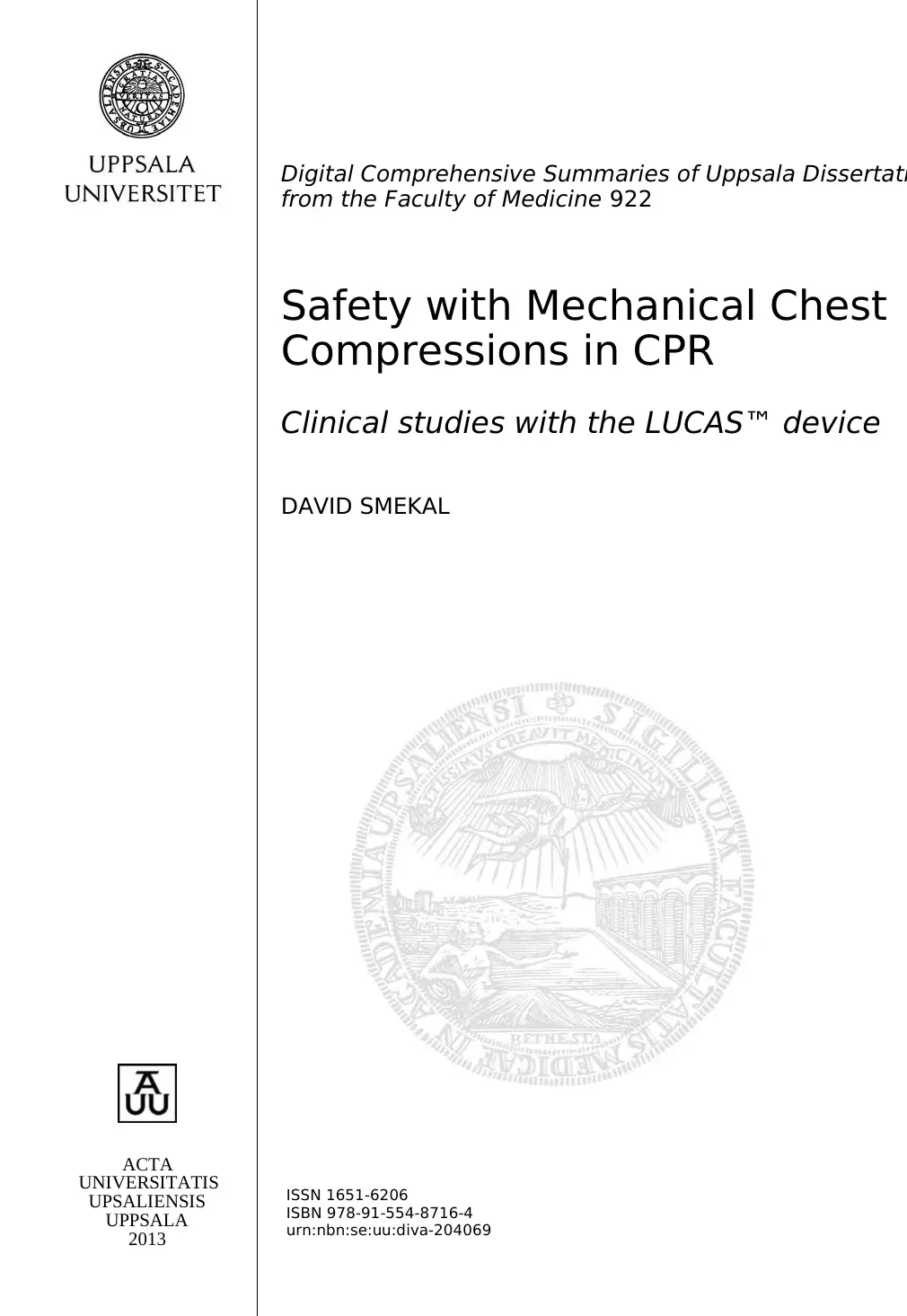
ACTA
UNIVERSITATIS
UPSALIENSIS
UPPSALA
2013
Digital Comprehensive Summaries of Uppsala Dissertati
from the Faculty of Medicine 922
Safety with Mechanical Chest
Compressions in CPR
Clinical studies with the LUCAS™ device
DAVID SMEKAL
ISSN 1651-6206
ISBN 978-91-554-8716-4
urn:nbn:se:uu:diva-204069
UNIVERSITATIS
UPSALIENSIS
UPPSALA
2013
Digital Comprehensive Summaries of Uppsala Dissertati
from the Faculty of Medicine 922
Safety with Mechanical Chest
Compressions in CPR
Clinical studies with the LUCAS™ device
DAVID SMEKAL
ISSN 1651-6206
ISBN 978-91-554-8716-4
urn:nbn:se:uu:diva-204069
Paraphrase This Document
Need a fresh take? Get an instant paraphrase of this document with our AI Paraphraser
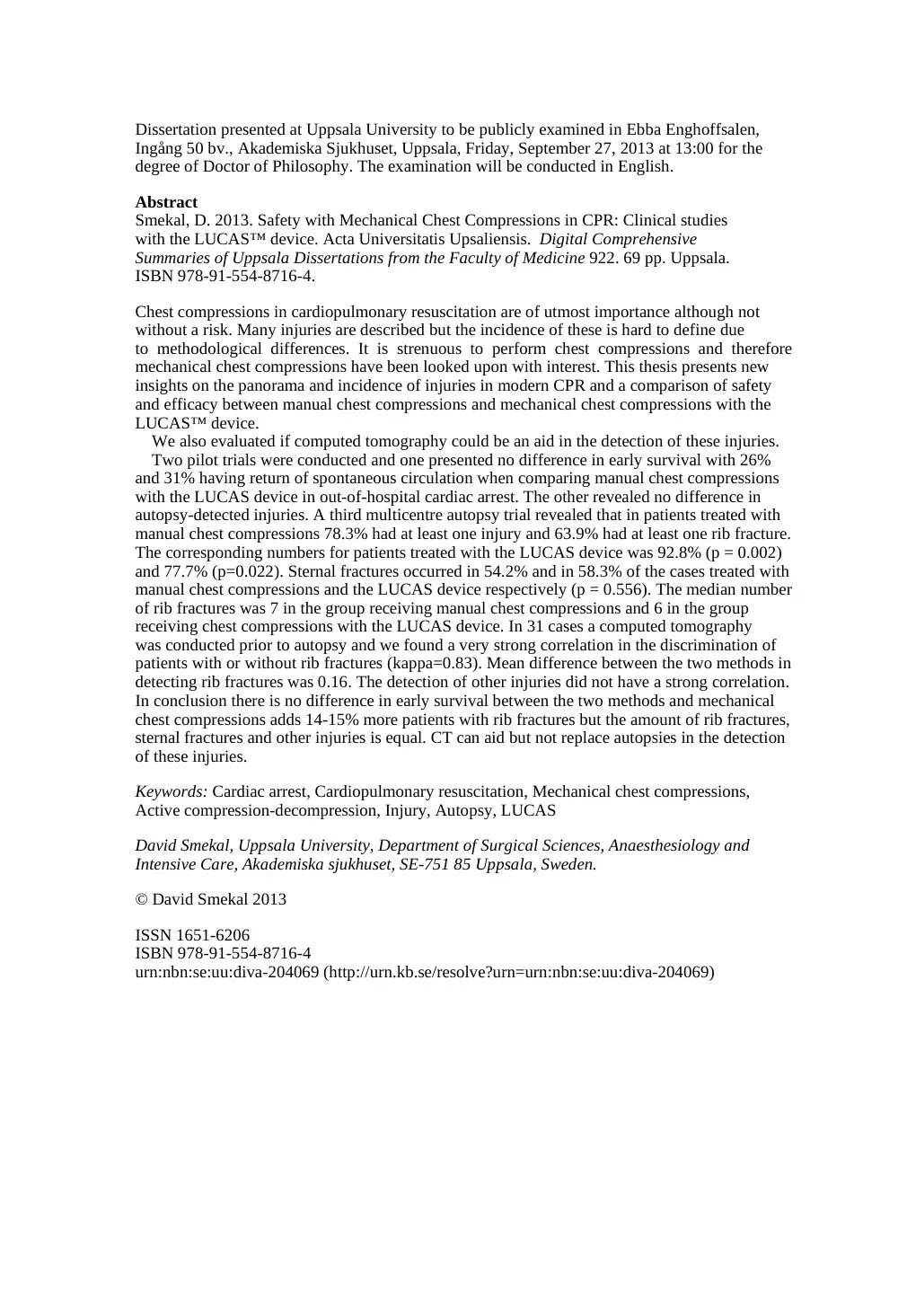
Dissertation presented at Uppsala University to be publicly examined in Ebba Enghoffsalen,
Ingång 50 bv., Akademiska Sjukhuset, Uppsala, Friday, September 27, 2013 at 13:00 for the
degree of Doctor of Philosophy. The examination will be conducted in English.
Abstract
Smekal, D. 2013. Safety with Mechanical Chest Compressions in CPR: Clinical studies
with the LUCAS™ device. Acta Universitatis Upsaliensis. Digital Comprehensive
Summaries of Uppsala Dissertations from the Faculty of Medicine 922. 69 pp. Uppsala.
ISBN 978-91-554-8716-4.
Chest compressions in cardiopulmonary resuscitation are of utmost importance although not
without a risk. Many injuries are described but the incidence of these is hard to define due
to methodological differences. It is strenuous to perform chest compressions and therefore
mechanical chest compressions have been looked upon with interest. This thesis presents new
insights on the panorama and incidence of injuries in modern CPR and a comparison of safety
and efficacy between manual chest compressions and mechanical chest compressions with the
LUCAS™ device.
We also evaluated if computed tomography could be an aid in the detection of these injuries.
Two pilot trials were conducted and one presented no difference in early survival with 26%
and 31% having return of spontaneous circulation when comparing manual chest compressions
with the LUCAS device in out-of-hospital cardiac arrest. The other revealed no difference in
autopsy-detected injuries. A third multicentre autopsy trial revealed that in patients treated with
manual chest compressions 78.3% had at least one injury and 63.9% had at least one rib fracture.
The corresponding numbers for patients treated with the LUCAS device was 92.8% (p = 0.002)
and 77.7% (p=0.022). Sternal fractures occurred in 54.2% and in 58.3% of the cases treated with
manual chest compressions and the LUCAS device respectively (p = 0.556). The median number
of rib fractures was 7 in the group receiving manual chest compressions and 6 in the group
receiving chest compressions with the LUCAS device. In 31 cases a computed tomography
was conducted prior to autopsy and we found a very strong correlation in the discrimination of
patients with or without rib fractures (kappa=0.83). Mean difference between the two methods in
detecting rib fractures was 0.16. The detection of other injuries did not have a strong correlation.
In conclusion there is no difference in early survival between the two methods and mechanical
chest compressions adds 14-15% more patients with rib fractures but the amount of rib fractures,
sternal fractures and other injuries is equal. CT can aid but not replace autopsies in the detection
of these injuries.
Keywords: Cardiac arrest, Cardiopulmonary resuscitation, Mechanical chest compressions,
Active compression-decompression, Injury, Autopsy, LUCAS
David Smekal, Uppsala University, Department of Surgical Sciences, Anaesthesiology and
Intensive Care, Akademiska sjukhuset, SE-751 85 Uppsala, Sweden.
© David Smekal 2013
ISSN 1651-6206
ISBN 978-91-554-8716-4
urn:nbn:se:uu:diva-204069 (http://urn.kb.se/resolve?urn=urn:nbn:se:uu:diva-204069)
Ingång 50 bv., Akademiska Sjukhuset, Uppsala, Friday, September 27, 2013 at 13:00 for the
degree of Doctor of Philosophy. The examination will be conducted in English.
Abstract
Smekal, D. 2013. Safety with Mechanical Chest Compressions in CPR: Clinical studies
with the LUCAS™ device. Acta Universitatis Upsaliensis. Digital Comprehensive
Summaries of Uppsala Dissertations from the Faculty of Medicine 922. 69 pp. Uppsala.
ISBN 978-91-554-8716-4.
Chest compressions in cardiopulmonary resuscitation are of utmost importance although not
without a risk. Many injuries are described but the incidence of these is hard to define due
to methodological differences. It is strenuous to perform chest compressions and therefore
mechanical chest compressions have been looked upon with interest. This thesis presents new
insights on the panorama and incidence of injuries in modern CPR and a comparison of safety
and efficacy between manual chest compressions and mechanical chest compressions with the
LUCAS™ device.
We also evaluated if computed tomography could be an aid in the detection of these injuries.
Two pilot trials were conducted and one presented no difference in early survival with 26%
and 31% having return of spontaneous circulation when comparing manual chest compressions
with the LUCAS device in out-of-hospital cardiac arrest. The other revealed no difference in
autopsy-detected injuries. A third multicentre autopsy trial revealed that in patients treated with
manual chest compressions 78.3% had at least one injury and 63.9% had at least one rib fracture.
The corresponding numbers for patients treated with the LUCAS device was 92.8% (p = 0.002)
and 77.7% (p=0.022). Sternal fractures occurred in 54.2% and in 58.3% of the cases treated with
manual chest compressions and the LUCAS device respectively (p = 0.556). The median number
of rib fractures was 7 in the group receiving manual chest compressions and 6 in the group
receiving chest compressions with the LUCAS device. In 31 cases a computed tomography
was conducted prior to autopsy and we found a very strong correlation in the discrimination of
patients with or without rib fractures (kappa=0.83). Mean difference between the two methods in
detecting rib fractures was 0.16. The detection of other injuries did not have a strong correlation.
In conclusion there is no difference in early survival between the two methods and mechanical
chest compressions adds 14-15% more patients with rib fractures but the amount of rib fractures,
sternal fractures and other injuries is equal. CT can aid but not replace autopsies in the detection
of these injuries.
Keywords: Cardiac arrest, Cardiopulmonary resuscitation, Mechanical chest compressions,
Active compression-decompression, Injury, Autopsy, LUCAS
David Smekal, Uppsala University, Department of Surgical Sciences, Anaesthesiology and
Intensive Care, Akademiska sjukhuset, SE-751 85 Uppsala, Sweden.
© David Smekal 2013
ISSN 1651-6206
ISBN 978-91-554-8716-4
urn:nbn:se:uu:diva-204069 (http://urn.kb.se/resolve?urn=urn:nbn:se:uu:diva-204069)

“Life is short, and Art long; the crisis fleeting; experience perilous, and deci-
sion difficult. The physician must not only be prepared to do what is right
himself, but also to make the patient, the attendants, and externals cooperate.”
Hippocrates 400 BC
To those I care about
sion difficult. The physician must not only be prepared to do what is right
himself, but also to make the patient, the attendants, and externals cooperate.”
Hippocrates 400 BC
To those I care about
⊘ This is a preview!⊘
Do you want full access?
Subscribe today to unlock all pages.

Trusted by 1+ million students worldwide

Paraphrase This Document
Need a fresh take? Get an instant paraphrase of this document with our AI Paraphraser
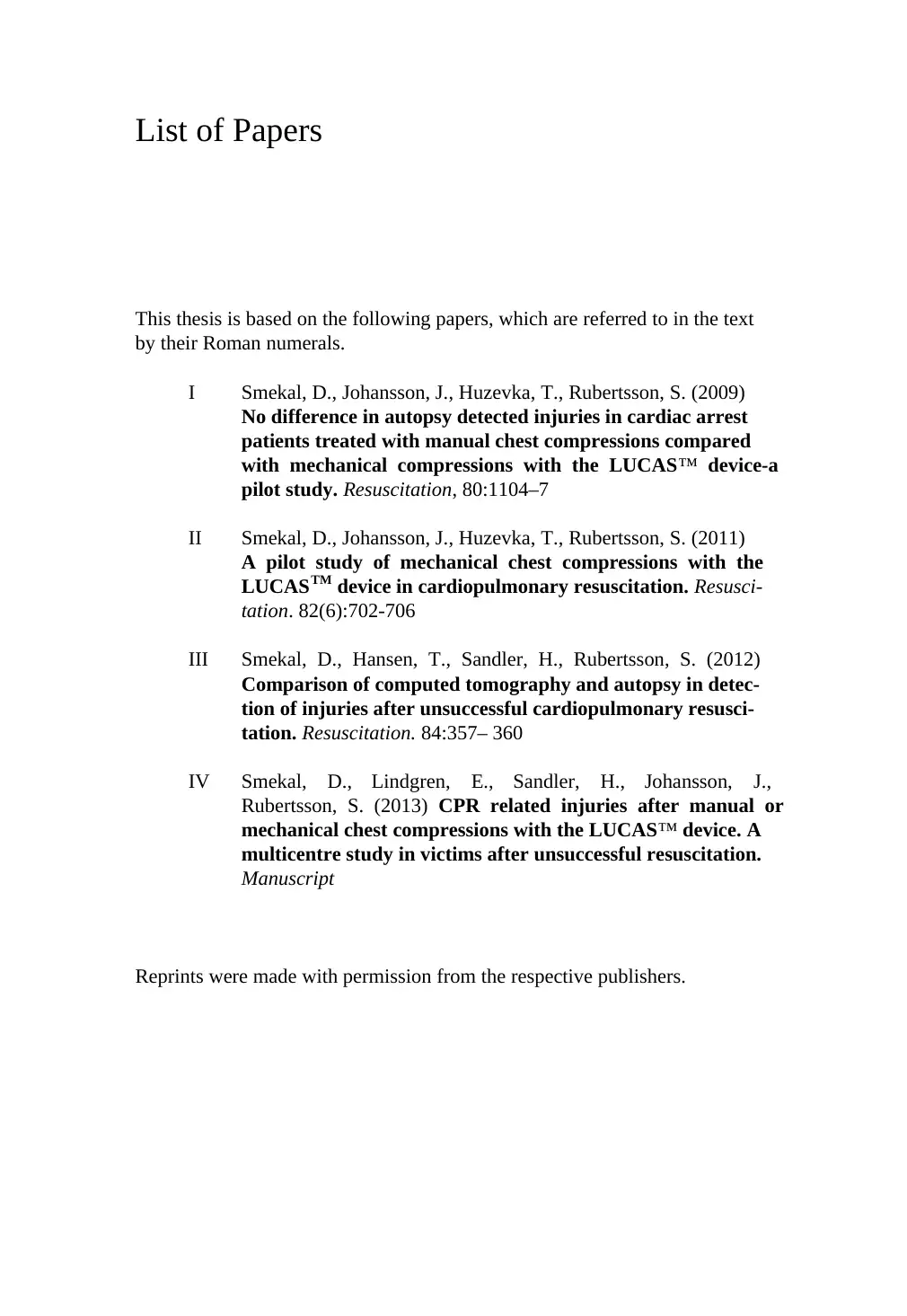
List of Papers
This thesis is based on the following papers, which are referred to in the text
by their Roman numerals.
I Smekal, D., Johansson, J., Huzevka, T., Rubertsson, S. (2009)
No difference in autopsy detected injuries in cardiac arrest
patients treated with manual chest compressions compared
with mechanical compressions with the LUCAS™ device-a
pilot study. Resuscitation, 80:1104–7
II Smekal, D., Johansson, J., Huzevka, T., Rubertsson, S. (2011)
A pilot study of mechanical chest compressions with the
LUCASTM device in cardiopulmonary resuscitation. Resusci-
tation. 82(6):702-706
III Smekal, D., Hansen, T., Sandler, H., Rubertsson, S. (2012)
Comparison of computed tomography and autopsy in detec-
tion of injuries after unsuccessful cardiopulmonary resusci-
tation. Resuscitation. 84:357– 360
IV Smekal, D., Lindgren, E., Sandler, H., Johansson, J.,
Rubertsson, S. (2013) CPR related injuries after manual or
mechanical chest compressions with the LUCAS™ device. A
multicentre study in victims after unsuccessful resuscitation.
Manuscript
Reprints were made with permission from the respective publishers.
This thesis is based on the following papers, which are referred to in the text
by their Roman numerals.
I Smekal, D., Johansson, J., Huzevka, T., Rubertsson, S. (2009)
No difference in autopsy detected injuries in cardiac arrest
patients treated with manual chest compressions compared
with mechanical compressions with the LUCAS™ device-a
pilot study. Resuscitation, 80:1104–7
II Smekal, D., Johansson, J., Huzevka, T., Rubertsson, S. (2011)
A pilot study of mechanical chest compressions with the
LUCASTM device in cardiopulmonary resuscitation. Resusci-
tation. 82(6):702-706
III Smekal, D., Hansen, T., Sandler, H., Rubertsson, S. (2012)
Comparison of computed tomography and autopsy in detec-
tion of injuries after unsuccessful cardiopulmonary resusci-
tation. Resuscitation. 84:357– 360
IV Smekal, D., Lindgren, E., Sandler, H., Johansson, J.,
Rubertsson, S. (2013) CPR related injuries after manual or
mechanical chest compressions with the LUCAS™ device. A
multicentre study in victims after unsuccessful resuscitation.
Manuscript
Reprints were made with permission from the respective publishers.

⊘ This is a preview!⊘
Do you want full access?
Subscribe today to unlock all pages.

Trusted by 1+ million students worldwide
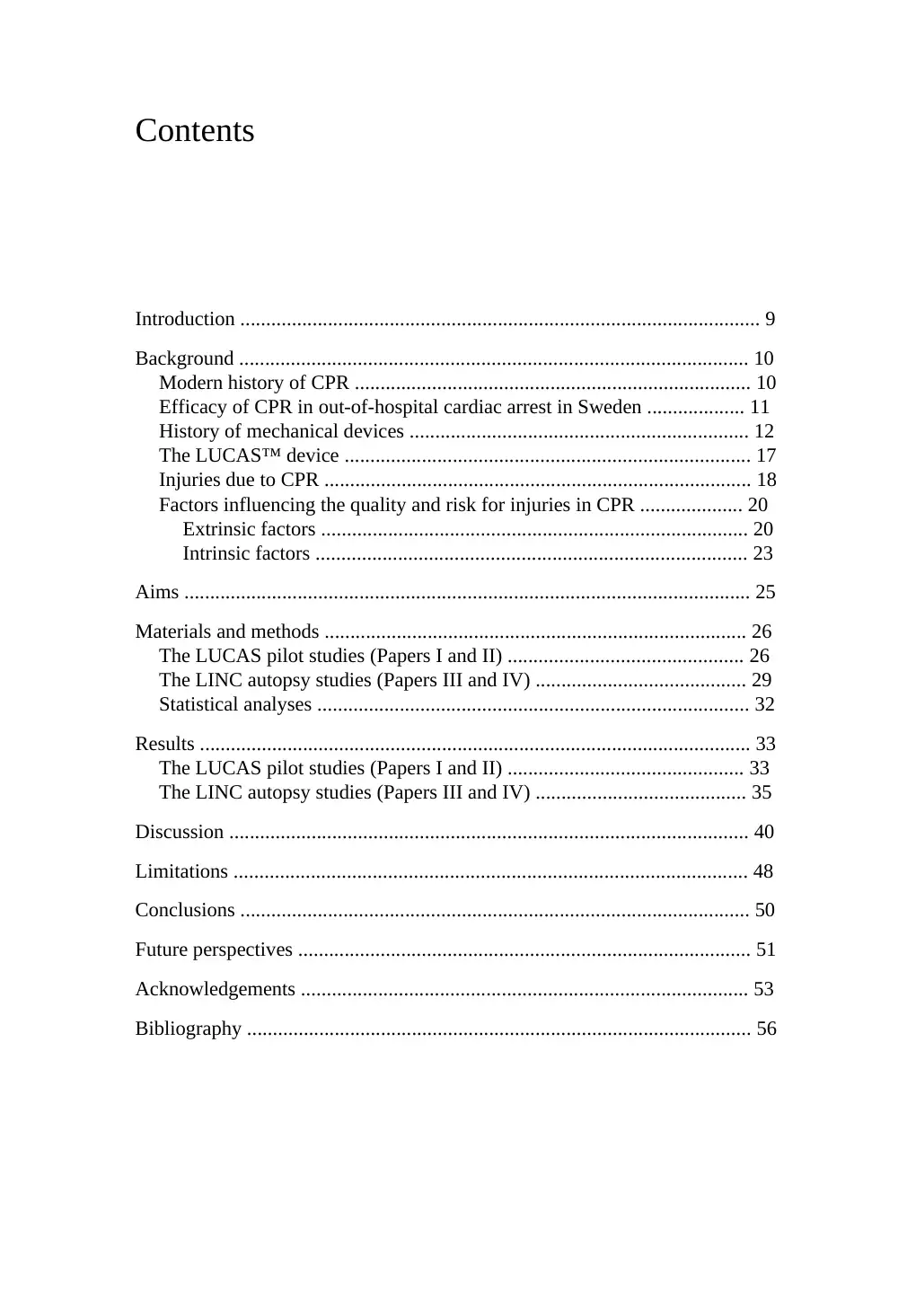
Contents
Introduction ..................................................................................................... 9
Background ................................................................................................... 10
Modern history of CPR ............................................................................. 10
Efficacy of CPR in out-of-hospital cardiac arrest in Sweden ................... 11
History of mechanical devices .................................................................. 12
The LUCAS™ device ............................................................................... 17
Injuries due to CPR ................................................................................... 18
Factors influencing the quality and risk for injuries in CPR .................... 20
Extrinsic factors ................................................................................... 20
Intrinsic factors .................................................................................... 23
Aims .............................................................................................................. 25
Materials and methods .................................................................................. 26
The LUCAS pilot studies (Papers I and II) .............................................. 26
The LINC autopsy studies (Papers III and IV) ......................................... 29
Statistical analyses .................................................................................... 32
Results ........................................................................................................... 33
The LUCAS pilot studies (Papers I and II) .............................................. 33
The LINC autopsy studies (Papers III and IV) ......................................... 35
Discussion ..................................................................................................... 40
Limitations .................................................................................................... 48
Conclusions ................................................................................................... 50
Future perspectives ........................................................................................ 51
Acknowledgements ....................................................................................... 53
Bibliography .................................................................................................. 56
Introduction ..................................................................................................... 9
Background ................................................................................................... 10
Modern history of CPR ............................................................................. 10
Efficacy of CPR in out-of-hospital cardiac arrest in Sweden ................... 11
History of mechanical devices .................................................................. 12
The LUCAS™ device ............................................................................... 17
Injuries due to CPR ................................................................................... 18
Factors influencing the quality and risk for injuries in CPR .................... 20
Extrinsic factors ................................................................................... 20
Intrinsic factors .................................................................................... 23
Aims .............................................................................................................. 25
Materials and methods .................................................................................. 26
The LUCAS pilot studies (Papers I and II) .............................................. 26
The LINC autopsy studies (Papers III and IV) ......................................... 29
Statistical analyses .................................................................................... 32
Results ........................................................................................................... 33
The LUCAS pilot studies (Papers I and II) .............................................. 33
The LINC autopsy studies (Papers III and IV) ......................................... 35
Discussion ..................................................................................................... 40
Limitations .................................................................................................... 48
Conclusions ................................................................................................... 50
Future perspectives ........................................................................................ 51
Acknowledgements ....................................................................................... 53
Bibliography .................................................................................................. 56
Paraphrase This Document
Need a fresh take? Get an instant paraphrase of this document with our AI Paraphraser
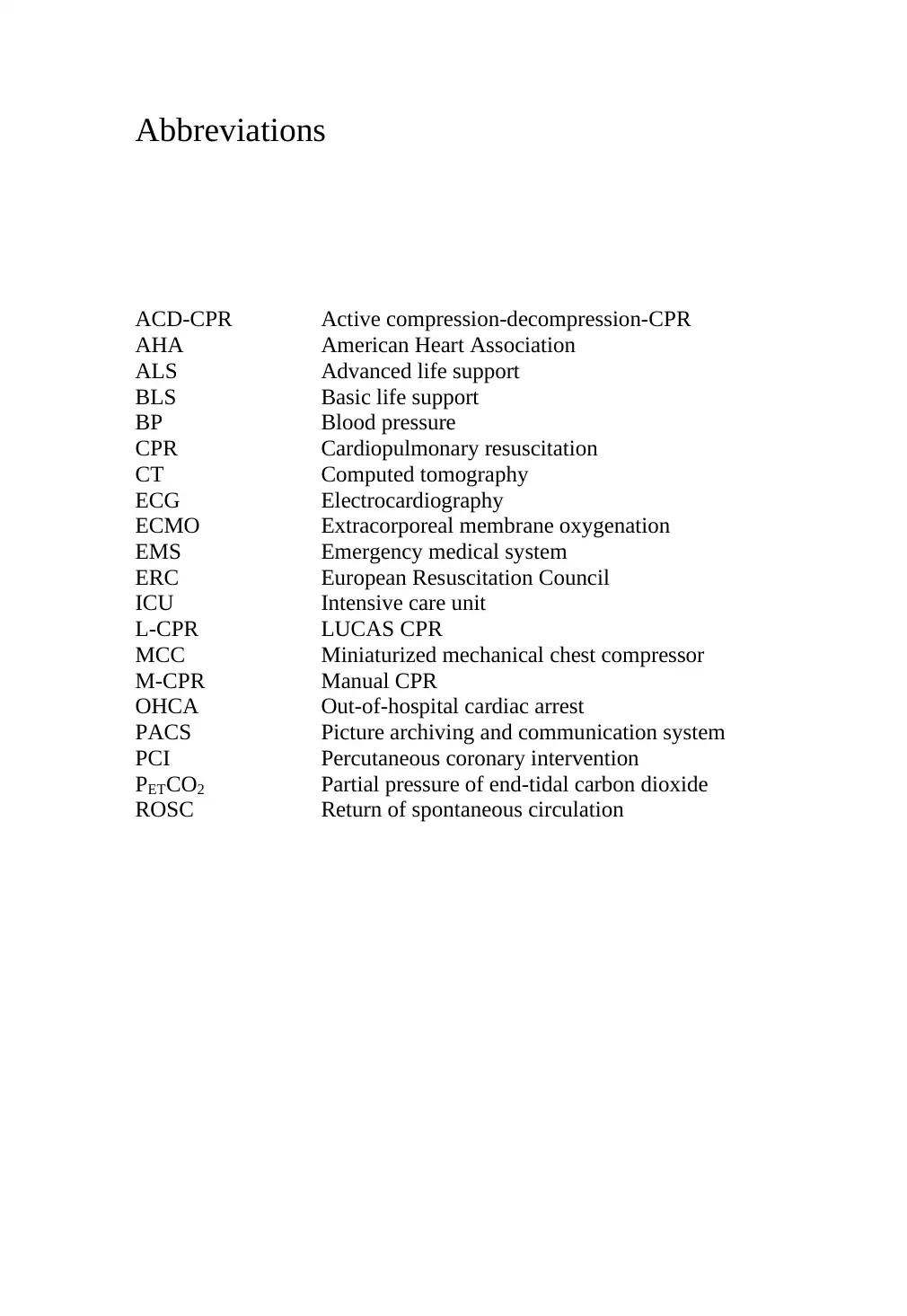
Abbreviations
ACD-CPR Active compression-decompression-CPR
AHA American Heart Association
ALS Advanced life support
BLS Basic life support
BP Blood pressure
CPR Cardiopulmonary resuscitation
CT Computed tomography
ECG Electrocardiography
ECMO Extracorporeal membrane oxygenation
EMS Emergency medical system
ERC European Resuscitation Council
ICU Intensive care unit
L-CPR LUCAS CPR
MCC Miniaturized mechanical chest compressor
M-CPR Manual CPR
OHCA Out-of-hospital cardiac arrest
PACS Picture archiving and communication system
PCI Percutaneous coronary intervention
PETCO2 Partial pressure of end-tidal carbon dioxide
ROSC Return of spontaneous circulation
ACD-CPR Active compression-decompression-CPR
AHA American Heart Association
ALS Advanced life support
BLS Basic life support
BP Blood pressure
CPR Cardiopulmonary resuscitation
CT Computed tomography
ECG Electrocardiography
ECMO Extracorporeal membrane oxygenation
EMS Emergency medical system
ERC European Resuscitation Council
ICU Intensive care unit
L-CPR LUCAS CPR
MCC Miniaturized mechanical chest compressor
M-CPR Manual CPR
OHCA Out-of-hospital cardiac arrest
PACS Picture archiving and communication system
PCI Percutaneous coronary intervention
PETCO2 Partial pressure of end-tidal carbon dioxide
ROSC Return of spontaneous circulation
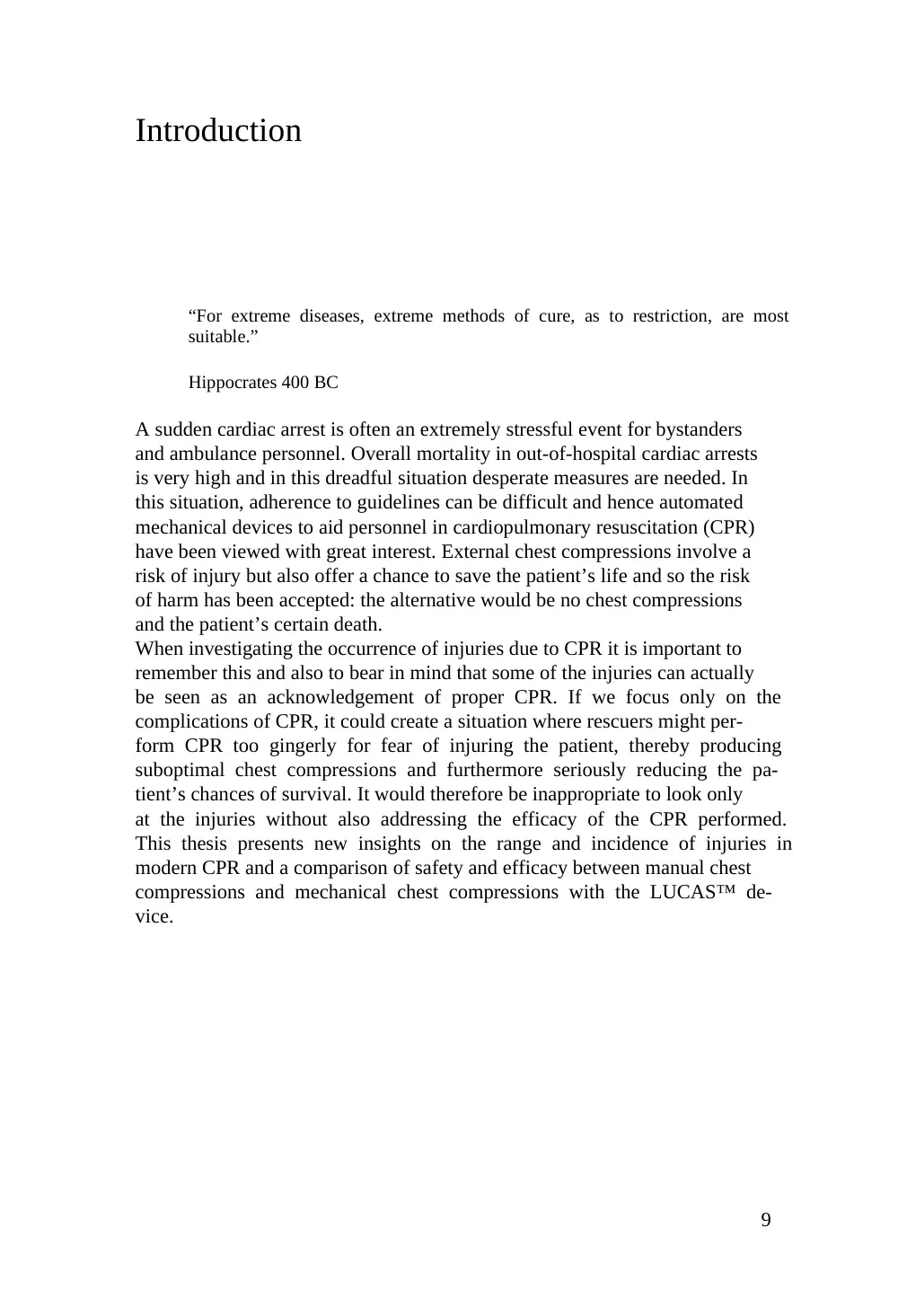
9
Introduction
“For extreme diseases, extreme methods of cure, as to restriction, are most
suitable.”
Hippocrates 400 BC
A sudden cardiac arrest is often an extremely stressful event for bystanders
and ambulance personnel. Overall mortality in out-of-hospital cardiac arrests
is very high and in this dreadful situation desperate measures are needed. In
this situation, adherence to guidelines can be difficult and hence automated
mechanical devices to aid personnel in cardiopulmonary resuscitation (CPR)
have been viewed with great interest. External chest compressions involve a
risk of injury but also offer a chance to save the patient’s life and so the risk
of harm has been accepted: the alternative would be no chest compressions
and the patient’s certain death.
When investigating the occurrence of injuries due to CPR it is important to
remember this and also to bear in mind that some of the injuries can actually
be seen as an acknowledgement of proper CPR. If we focus only on the
complications of CPR, it could create a situation where rescuers might per-
form CPR too gingerly for fear of injuring the patient, thereby producing
suboptimal chest compressions and furthermore seriously reducing the pa-
tient’s chances of survival. It would therefore be inappropriate to look only
at the injuries without also addressing the efficacy of the CPR performed.
This thesis presents new insights on the range and incidence of injuries in
modern CPR and a comparison of safety and efficacy between manual chest
compressions and mechanical chest compressions with the LUCAS™ de-
vice.
Introduction
“For extreme diseases, extreme methods of cure, as to restriction, are most
suitable.”
Hippocrates 400 BC
A sudden cardiac arrest is often an extremely stressful event for bystanders
and ambulance personnel. Overall mortality in out-of-hospital cardiac arrests
is very high and in this dreadful situation desperate measures are needed. In
this situation, adherence to guidelines can be difficult and hence automated
mechanical devices to aid personnel in cardiopulmonary resuscitation (CPR)
have been viewed with great interest. External chest compressions involve a
risk of injury but also offer a chance to save the patient’s life and so the risk
of harm has been accepted: the alternative would be no chest compressions
and the patient’s certain death.
When investigating the occurrence of injuries due to CPR it is important to
remember this and also to bear in mind that some of the injuries can actually
be seen as an acknowledgement of proper CPR. If we focus only on the
complications of CPR, it could create a situation where rescuers might per-
form CPR too gingerly for fear of injuring the patient, thereby producing
suboptimal chest compressions and furthermore seriously reducing the pa-
tient’s chances of survival. It would therefore be inappropriate to look only
at the injuries without also addressing the efficacy of the CPR performed.
This thesis presents new insights on the range and incidence of injuries in
modern CPR and a comparison of safety and efficacy between manual chest
compressions and mechanical chest compressions with the LUCAS™ de-
vice.
⊘ This is a preview!⊘
Do you want full access?
Subscribe today to unlock all pages.

Trusted by 1+ million students worldwide
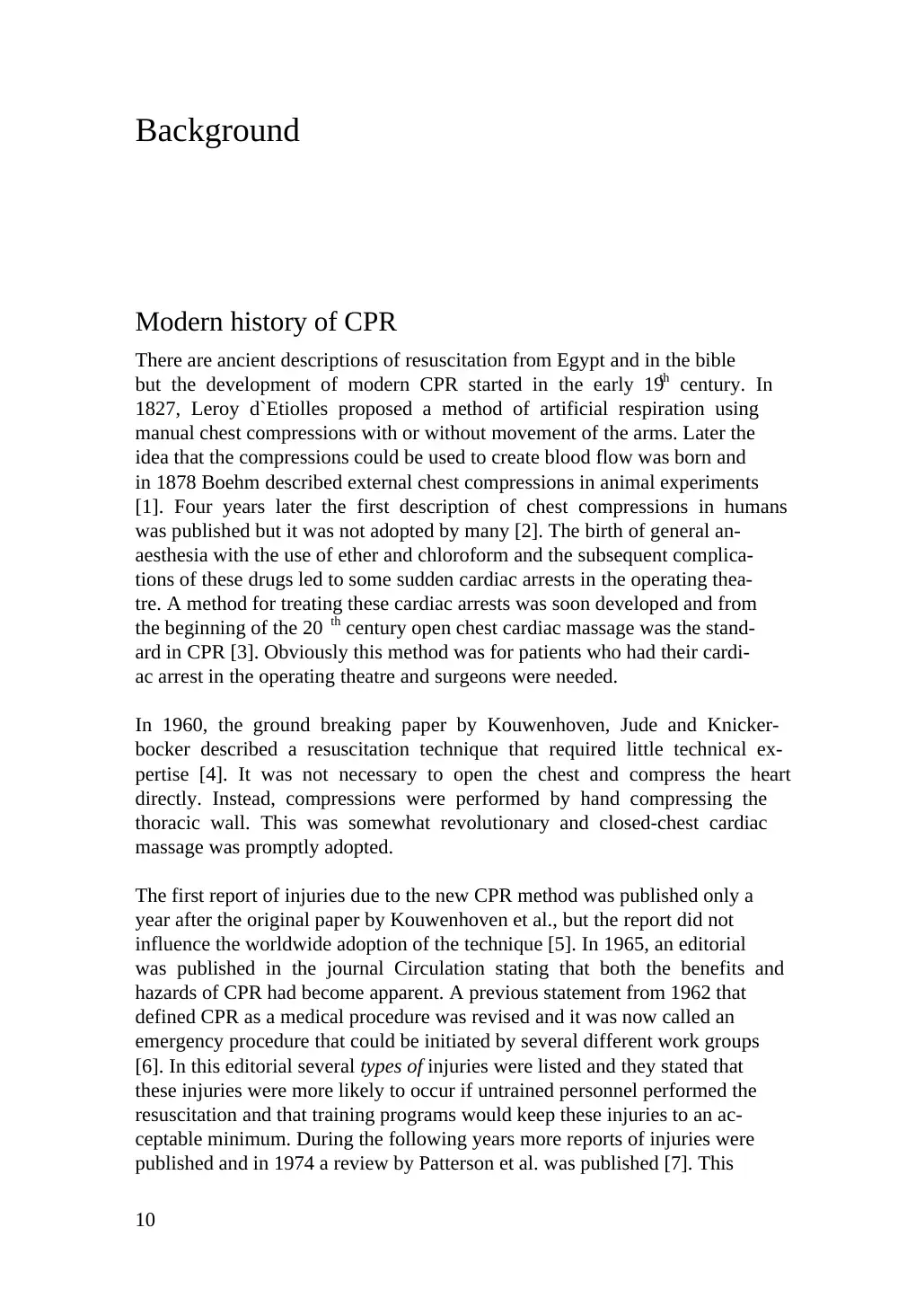
10
Background
Modern history of CPR
There are ancient descriptions of resuscitation from Egypt and in the bible
but the development of modern CPR started in the early 19th century. In
1827, Leroy d`Etiolles proposed a method of artificial respiration using
manual chest compressions with or without movement of the arms. Later the
idea that the compressions could be used to create blood flow was born and
in 1878 Boehm described external chest compressions in animal experiments
[1]. Four years later the first description of chest compressions in humans
was published but it was not adopted by many [2]. The birth of general an-
aesthesia with the use of ether and chloroform and the subsequent complica-
tions of these drugs led to some sudden cardiac arrests in the operating thea-
tre. A method for treating these cardiac arrests was soon developed and from
the beginning of the 20 th century open chest cardiac massage was the stand-
ard in CPR [3]. Obviously this method was for patients who had their cardi-
ac arrest in the operating theatre and surgeons were needed.
In 1960, the ground breaking paper by Kouwenhoven, Jude and Knicker-
bocker described a resuscitation technique that required little technical ex-
pertise [4]. It was not necessary to open the chest and compress the heart
directly. Instead, compressions were performed by hand compressing the
thoracic wall. This was somewhat revolutionary and closed-chest cardiac
massage was promptly adopted.
The first report of injuries due to the new CPR method was published only a
year after the original paper by Kouwenhoven et al., but the report did not
influence the worldwide adoption of the technique [5]. In 1965, an editorial
was published in the journal Circulation stating that both the benefits and
hazards of CPR had become apparent. A previous statement from 1962 that
defined CPR as a medical procedure was revised and it was now called an
emergency procedure that could be initiated by several different work groups
[6]. In this editorial several types of injuries were listed and they stated that
these injuries were more likely to occur if untrained personnel performed the
resuscitation and that training programs would keep these injuries to an ac-
ceptable minimum. During the following years more reports of injuries were
published and in 1974 a review by Patterson et al. was published [7]. This
Background
Modern history of CPR
There are ancient descriptions of resuscitation from Egypt and in the bible
but the development of modern CPR started in the early 19th century. In
1827, Leroy d`Etiolles proposed a method of artificial respiration using
manual chest compressions with or without movement of the arms. Later the
idea that the compressions could be used to create blood flow was born and
in 1878 Boehm described external chest compressions in animal experiments
[1]. Four years later the first description of chest compressions in humans
was published but it was not adopted by many [2]. The birth of general an-
aesthesia with the use of ether and chloroform and the subsequent complica-
tions of these drugs led to some sudden cardiac arrests in the operating thea-
tre. A method for treating these cardiac arrests was soon developed and from
the beginning of the 20 th century open chest cardiac massage was the stand-
ard in CPR [3]. Obviously this method was for patients who had their cardi-
ac arrest in the operating theatre and surgeons were needed.
In 1960, the ground breaking paper by Kouwenhoven, Jude and Knicker-
bocker described a resuscitation technique that required little technical ex-
pertise [4]. It was not necessary to open the chest and compress the heart
directly. Instead, compressions were performed by hand compressing the
thoracic wall. This was somewhat revolutionary and closed-chest cardiac
massage was promptly adopted.
The first report of injuries due to the new CPR method was published only a
year after the original paper by Kouwenhoven et al., but the report did not
influence the worldwide adoption of the technique [5]. In 1965, an editorial
was published in the journal Circulation stating that both the benefits and
hazards of CPR had become apparent. A previous statement from 1962 that
defined CPR as a medical procedure was revised and it was now called an
emergency procedure that could be initiated by several different work groups
[6]. In this editorial several types of injuries were listed and they stated that
these injuries were more likely to occur if untrained personnel performed the
resuscitation and that training programs would keep these injuries to an ac-
ceptable minimum. During the following years more reports of injuries were
published and in 1974 a review by Patterson et al. was published [7]. This
Paraphrase This Document
Need a fresh take? Get an instant paraphrase of this document with our AI Paraphraser
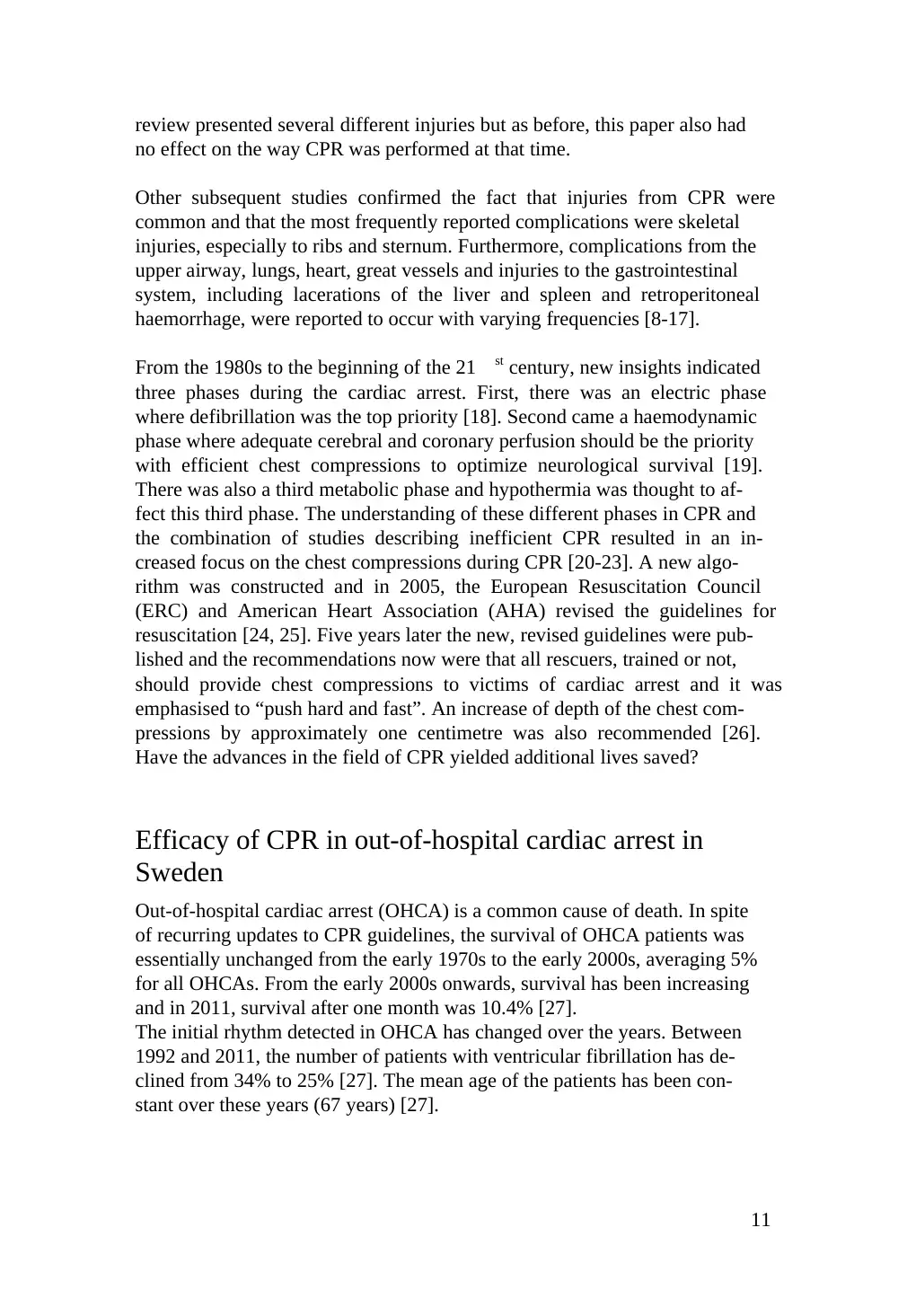
11
review presented several different injuries but as before, this paper also had
no effect on the way CPR was performed at that time.
Other subsequent studies confirmed the fact that injuries from CPR were
common and that the most frequently reported complications were skeletal
injuries, especially to ribs and sternum. Furthermore, complications from the
upper airway, lungs, heart, great vessels and injuries to the gastrointestinal
system, including lacerations of the liver and spleen and retroperitoneal
haemorrhage, were reported to occur with varying frequencies [8-17].
From the 1980s to the beginning of the 21 st century, new insights indicated
three phases during the cardiac arrest. First, there was an electric phase
where defibrillation was the top priority [18]. Second came a haemodynamic
phase where adequate cerebral and coronary perfusion should be the priority
with efficient chest compressions to optimize neurological survival [19].
There was also a third metabolic phase and hypothermia was thought to af-
fect this third phase. The understanding of these different phases in CPR and
the combination of studies describing inefficient CPR resulted in an in-
creased focus on the chest compressions during CPR [20-23]. A new algo-
rithm was constructed and in 2005, the European Resuscitation Council
(ERC) and American Heart Association (AHA) revised the guidelines for
resuscitation [24, 25]. Five years later the new, revised guidelines were pub-
lished and the recommendations now were that all rescuers, trained or not,
should provide chest compressions to victims of cardiac arrest and it was
emphasised to “push hard and fast”. An increase of depth of the chest com-
pressions by approximately one centimetre was also recommended [26].
Have the advances in the field of CPR yielded additional lives saved?
Efficacy of CPR in out-of-hospital cardiac arrest in
Sweden
Out-of-hospital cardiac arrest (OHCA) is a common cause of death. In spite
of recurring updates to CPR guidelines, the survival of OHCA patients was
essentially unchanged from the early 1970s to the early 2000s, averaging 5%
for all OHCAs. From the early 2000s onwards, survival has been increasing
and in 2011, survival after one month was 10.4% [27].
The initial rhythm detected in OHCA has changed over the years. Between
1992 and 2011, the number of patients with ventricular fibrillation has de-
clined from 34% to 25% [27]. The mean age of the patients has been con-
stant over these years (67 years) [27].
review presented several different injuries but as before, this paper also had
no effect on the way CPR was performed at that time.
Other subsequent studies confirmed the fact that injuries from CPR were
common and that the most frequently reported complications were skeletal
injuries, especially to ribs and sternum. Furthermore, complications from the
upper airway, lungs, heart, great vessels and injuries to the gastrointestinal
system, including lacerations of the liver and spleen and retroperitoneal
haemorrhage, were reported to occur with varying frequencies [8-17].
From the 1980s to the beginning of the 21 st century, new insights indicated
three phases during the cardiac arrest. First, there was an electric phase
where defibrillation was the top priority [18]. Second came a haemodynamic
phase where adequate cerebral and coronary perfusion should be the priority
with efficient chest compressions to optimize neurological survival [19].
There was also a third metabolic phase and hypothermia was thought to af-
fect this third phase. The understanding of these different phases in CPR and
the combination of studies describing inefficient CPR resulted in an in-
creased focus on the chest compressions during CPR [20-23]. A new algo-
rithm was constructed and in 2005, the European Resuscitation Council
(ERC) and American Heart Association (AHA) revised the guidelines for
resuscitation [24, 25]. Five years later the new, revised guidelines were pub-
lished and the recommendations now were that all rescuers, trained or not,
should provide chest compressions to victims of cardiac arrest and it was
emphasised to “push hard and fast”. An increase of depth of the chest com-
pressions by approximately one centimetre was also recommended [26].
Have the advances in the field of CPR yielded additional lives saved?
Efficacy of CPR in out-of-hospital cardiac arrest in
Sweden
Out-of-hospital cardiac arrest (OHCA) is a common cause of death. In spite
of recurring updates to CPR guidelines, the survival of OHCA patients was
essentially unchanged from the early 1970s to the early 2000s, averaging 5%
for all OHCAs. From the early 2000s onwards, survival has been increasing
and in 2011, survival after one month was 10.4% [27].
The initial rhythm detected in OHCA has changed over the years. Between
1992 and 2011, the number of patients with ventricular fibrillation has de-
clined from 34% to 25% [27]. The mean age of the patients has been con-
stant over these years (67 years) [27].
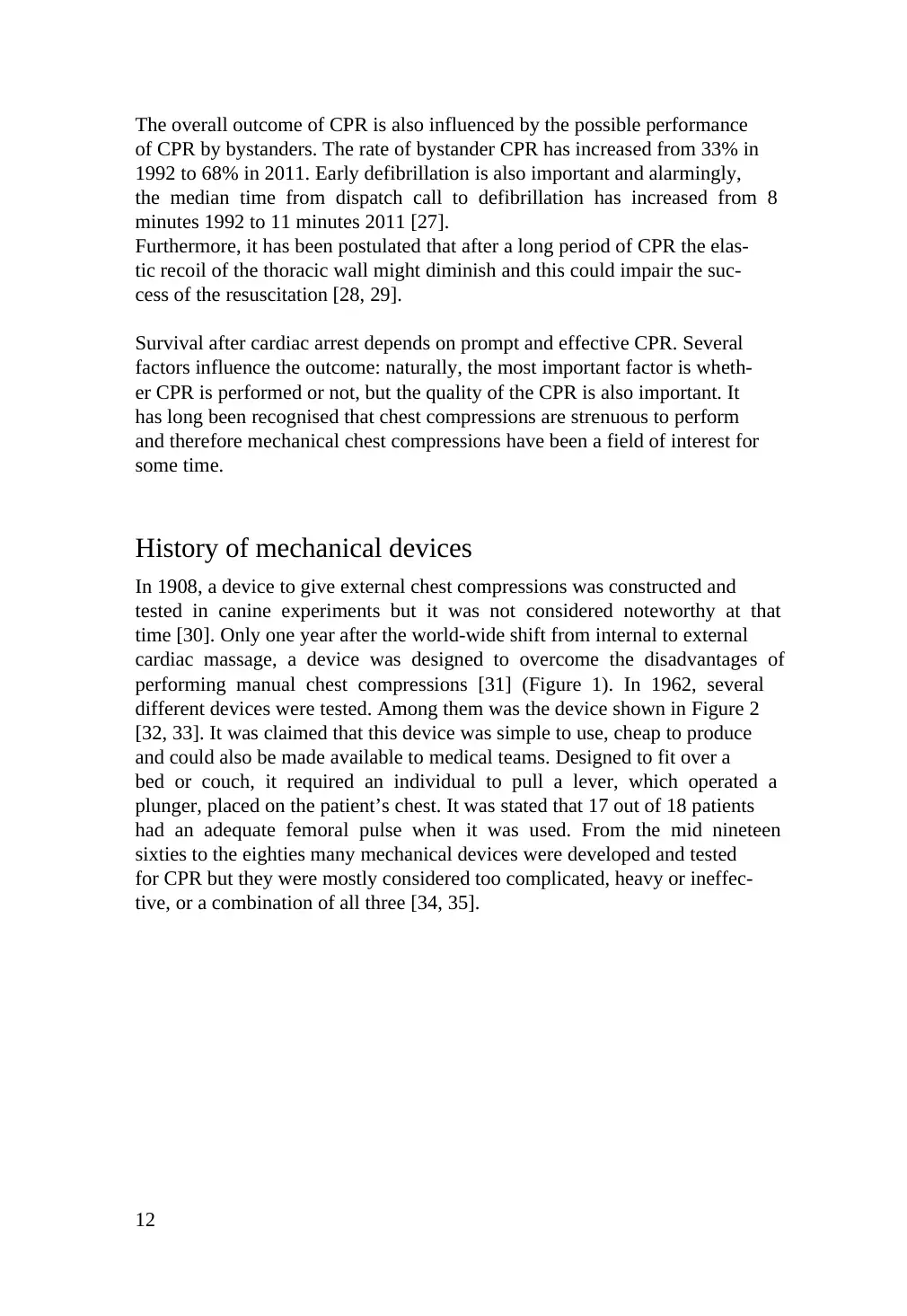
12
The overall outcome of CPR is also influenced by the possible performance
of CPR by bystanders. The rate of bystander CPR has increased from 33% in
1992 to 68% in 2011. Early defibrillation is also important and alarmingly,
the median time from dispatch call to defibrillation has increased from 8
minutes 1992 to 11 minutes 2011 [27].
Furthermore, it has been postulated that after a long period of CPR the elas-
tic recoil of the thoracic wall might diminish and this could impair the suc-
cess of the resuscitation [28, 29].
Survival after cardiac arrest depends on prompt and effective CPR. Several
factors influence the outcome: naturally, the most important factor is wheth-
er CPR is performed or not, but the quality of the CPR is also important. It
has long been recognised that chest compressions are strenuous to perform
and therefore mechanical chest compressions have been a field of interest for
some time.
History of mechanical devices
In 1908, a device to give external chest compressions was constructed and
tested in canine experiments but it was not considered noteworthy at that
time [30]. Only one year after the world-wide shift from internal to external
cardiac massage, a device was designed to overcome the disadvantages of
performing manual chest compressions [31] (Figure 1). In 1962, several
different devices were tested. Among them was the device shown in Figure 2
[32, 33]. It was claimed that this device was simple to use, cheap to produce
and could also be made available to medical teams. Designed to fit over a
bed or couch, it required an individual to pull a lever, which operated a
plunger, placed on the patient’s chest. It was stated that 17 out of 18 patients
had an adequate femoral pulse when it was used. From the mid nineteen
sixties to the eighties many mechanical devices were developed and tested
for CPR but they were mostly considered too complicated, heavy or ineffec-
tive, or a combination of all three [34, 35].
The overall outcome of CPR is also influenced by the possible performance
of CPR by bystanders. The rate of bystander CPR has increased from 33% in
1992 to 68% in 2011. Early defibrillation is also important and alarmingly,
the median time from dispatch call to defibrillation has increased from 8
minutes 1992 to 11 minutes 2011 [27].
Furthermore, it has been postulated that after a long period of CPR the elas-
tic recoil of the thoracic wall might diminish and this could impair the suc-
cess of the resuscitation [28, 29].
Survival after cardiac arrest depends on prompt and effective CPR. Several
factors influence the outcome: naturally, the most important factor is wheth-
er CPR is performed or not, but the quality of the CPR is also important. It
has long been recognised that chest compressions are strenuous to perform
and therefore mechanical chest compressions have been a field of interest for
some time.
History of mechanical devices
In 1908, a device to give external chest compressions was constructed and
tested in canine experiments but it was not considered noteworthy at that
time [30]. Only one year after the world-wide shift from internal to external
cardiac massage, a device was designed to overcome the disadvantages of
performing manual chest compressions [31] (Figure 1). In 1962, several
different devices were tested. Among them was the device shown in Figure 2
[32, 33]. It was claimed that this device was simple to use, cheap to produce
and could also be made available to medical teams. Designed to fit over a
bed or couch, it required an individual to pull a lever, which operated a
plunger, placed on the patient’s chest. It was stated that 17 out of 18 patients
had an adequate femoral pulse when it was used. From the mid nineteen
sixties to the eighties many mechanical devices were developed and tested
for CPR but they were mostly considered too complicated, heavy or ineffec-
tive, or a combination of all three [34, 35].
⊘ This is a preview!⊘
Do you want full access?
Subscribe today to unlock all pages.

Trusted by 1+ million students worldwide
1 out of 70
Your All-in-One AI-Powered Toolkit for Academic Success.
+13062052269
info@desklib.com
Available 24*7 on WhatsApp / Email
![[object Object]](/_next/static/media/star-bottom.7253800d.svg)
Unlock your academic potential
Copyright © 2020–2025 A2Z Services. All Rights Reserved. Developed and managed by ZUCOL.